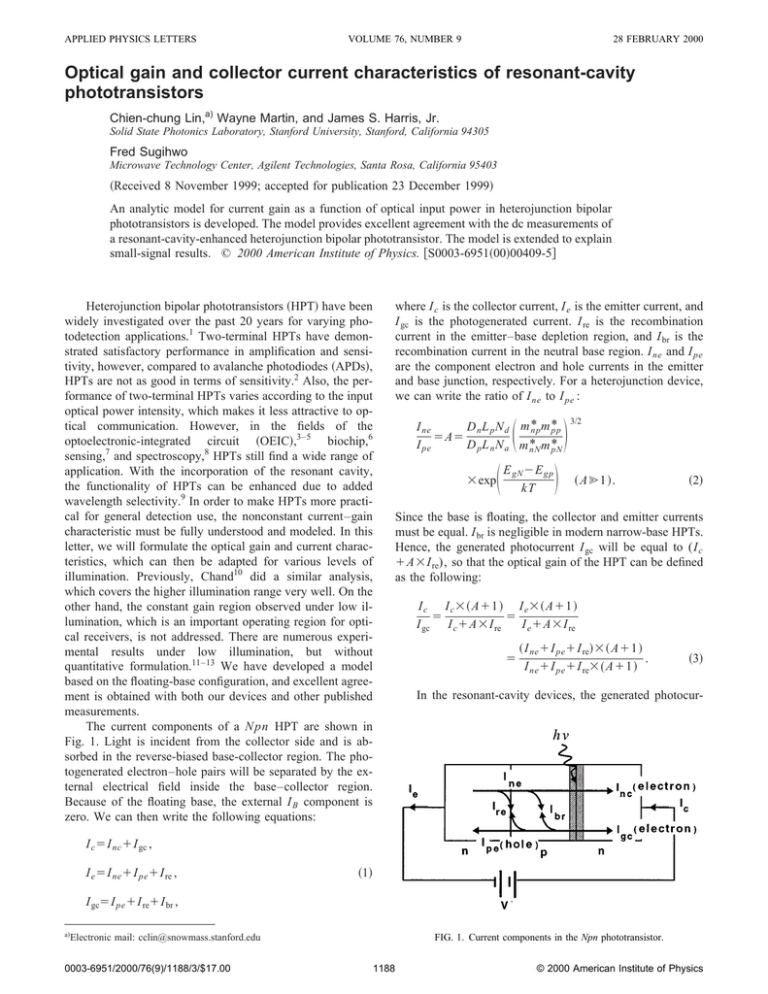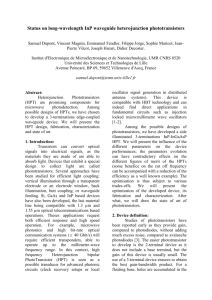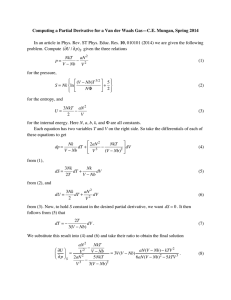Using APL format
advertisement

APPLIED PHYSICS LETTERS VOLUME 76, NUMBER 9 28 FEBRUARY 2000 Optical gain and collector current characteristics of resonant-cavity phototransistors Chien-chung Lin,a) Wayne Martin, and James S. Harris, Jr. Solid State Photonics Laboratory, Stanford University, Stanford, California 94305 Fred Sugihwo Microwave Technology Center, Agilent Technologies, Santa Rosa, California 95403 共Received 8 November 1999; accepted for publication 23 December 1999兲 An analytic model for current gain as a function of optical input power in heterojunction bipolar phototransistors is developed. The model provides excellent agreement with the dc measurements of a resonant-cavity-enhanced heterojunction bipolar phototransistor. The model is extended to explain small-signal results. © 2000 American Institute of Physics. 关S0003-6951共00兲00409-5兴 Heterojunction bipolar phototransistors 共HPT兲 have been widely investigated over the past 20 years for varying photodetection applications.1 Two-terminal HPTs have demonstrated satisfactory performance in amplification and sensitivity, however, compared to avalanche photodiodes 共APDs兲, HPTs are not as good in terms of sensitivity.2 Also, the performance of two-terminal HPTs varies according to the input optical power intensity, which makes it less attractive to optical communication. However, in the fields of the optoelectronic-integrated circuit 共OEIC兲,3–5 biochip,6 sensing,7 and spectroscopy,8 HPTs still find a wide range of application. With the incorporation of the resonant cavity, the functionality of HPTs can be enhanced due to added wavelength selectivity.9 In order to make HPTs more practical for general detection use, the nonconstant current–gain characteristic must be fully understood and modeled. In this letter, we will formulate the optical gain and current characteristics, which can then be adapted for various levels of illumination. Previously, Chand10 did a similar analysis, which covers the higher illumination range very well. On the other hand, the constant gain region observed under low illumination, which is an important operating region for optical receivers, is not addressed. There are numerous experimental results under low illumination, but without quantitative formulation.11–13 We have developed a model based on the floating-base configuration, and excellent agreement is obtained with both our devices and other published measurements. The current components of a N pn HPT are shown in Fig. 1. Light is incident from the collector side and is absorbed in the reverse-biased base-collector region. The photogenerated electron–hole pairs will be separated by the external electrical field inside the base–collector region. Because of the floating base, the external I B component is zero. We can then write the following equations: where I c is the collector current, I e is the emitter current, and I gc is the photogenerated current. I re is the recombination current in the emitter–base depletion region, and I br is the recombination current in the neutral base region. I ne and I pe are the component electron and hole currents in the emitter and base junction, respectively. For a heterojunction device, we can write the ratio of I ne to I pe : 冉 * m *pp D n L p N d m np I ne ⫽A⫽ * m *pN I pe D p L n N a m nN ⫻exp 冉 E gN ⫺E gp kT 冊 冊 3/2 共 AⰇ1 兲 . 共2兲 Since the base is floating, the collector and emitter currents must be equal. I br is negligible in modern narrow-base HPTs. Hence, the generated photocurrent I gc will be equal to (I c ⫹A⫻I re), so that the optical gain of the HPT can be defined as the following: I c I c ⫻ 共 A⫹1 兲 I e ⫻ 共 A⫹1 兲 ⫽ ⫽ I gc I c ⫹A⫻I re I e ⫹A⫻I re ⫽ 共 I ne ⫹I pe ⫹I re兲 ⫻ 共 A⫹1 兲 . I ne ⫹I pe ⫹I re⫻ 共 A⫹1 兲 共3兲 In the resonant-cavity devices, the generated photocur- I c ⫽I nc ⫹I gc , I e ⫽I ne ⫹I pe ⫹I re , 共1兲 I gc⫽I pe ⫹I re⫹I br , a兲 Electronic mail: cclin@snowmass.stanford.edu 0003-6951/2000/76(9)/1188/3/$17.00 FIG. 1. Current components in the Npn phototransistor. 1188 © 2000 American Institute of Physics Lin et al. Appl. Phys. Lett., Vol. 76, No. 9, 28 February 2000 1189 rent I gc can be related to the incident power through the following 共assuming every absorbed photon generates one electron–hole pair兲:9 P absorbed P incident ⫽⫽ 共 1⫹R 2 e ⫺ ␣ d 兲 1⫺2 冑R 1 R 2 e ⫺ ␣ d cos共 2  L⫹ 1 ⫹ 2 兲 ⫹R 1 R 2 e ⫺2 ␣ d ⫻ 共 1⫺R 1 兲共 1⫺e ⫺ ␣ d 兲 , 共4兲 where R 1 , R 2 are the reflectivity for top and bottom mirrors in the devices, ␣ is the absorption coefficient of the quantum well, d is the thickness of the quantum well, L is the cavity length, 1 and 2 are the phase added by top and bottom mirrors, respectively, and  is the propagation constant. Using the quantum efficiency of the device and the incident power intensity, we can derive the generated current from the Eq. 共5兲: I gc⫽Resp⫻ ⫻ P inicident , 共5兲 where the Resp is the responsivity at that wavelength. Considering the thermionic emission and generation– recombination equations in a standard p – n junction, one can postulate that I np ⫹I ne ⫽I f ⫽I f 0 (e qV BE /kT ⫺1) and I re ⫽I r0 (e qV BE /nkT ⫺1), where n is the diode ideality factor in the emitter–base junction. The factor n is nominally between 1 and 2 for homojunctions but can be larger than 2 in a heterojunction.14 I r0 will be slightly dependent on V BE via the depletion width modulation, which can be taken into account if a term 冑V bi⫺V BE is included and V bi is the built-in potential. Using this formula, one can immediately identify three regions of operation: 共a兲 When the illumination is low, V BE is small, qV BE ⰆkT, thus expanding the exponential gives: I f ⬇I f 0 ⫻qV BE /kT, and I re⬇I r0 ⫻qV BE /nkT. Substituting these two expressions into Eq. 共3兲: I c 共 I f ⫹I re兲 ⫻ 共 A⫹1 兲 ⫽ I gc I f ⫹I re⫻ 共 A⫹1 兲 冉 冊 FIG. 2. Typical I – V characteristics under different illumination intensities for the resonant-cavity-enhanced 共RCE兲 HPT. 共c兲 When illumination is high, such that I f ⰇA⫻I re , then I c 共 A⫹1 兲 I f ⬵ ⫽ 共 A⫹1 兲 ⫽h FE⫹1. I gc If 共8兲 Usually, HPTs seldom operate in this region. Because I pe will dominate the current, the ratio of I ne and I pe is actually the maximum current gain of the device. These three operating regimes have been described qualitatively elsewhere.1,13 With the above formulation, we can fit the actual data and extract the diode ideality factor and I f 0 ,I r0 . A small-signal model can be deduced directly from the ac components in Eq. 共1兲. If the intensity of the incident light is modulated with a small variation, the potential between the emitter–base junction will change correspondingly. If the small-signal components are denoted as lower-case variables, we can write the following expressions 共the variation of I r0 can be neglected to first order兲: qV BE qV BE ⫹I r0 共 A⫹1 兲 kT nkT ⬵ qV BE qV BE ⫹ 共 A⫹1 兲 ⫻I r0 If0 kT nkT 冉 If0 冊 I r0 共 A⫹1 兲 n . ⫽ 共 A⫹1 兲 I r0 I f 0⫹ n I f 0⫹ 共6兲 Equation 共4兲 will have a constant value, independent of how much current I c flows through the device in this lowillumination regime. 共b兲 When illumination is in the intermediate regime, I f ⬎I re , but I f ⭐A⫻I re , then I c 共 A⫹1 兲 I f I f 0 ⬵ ⬵ ⫻ 共 e 共 qV BE /kT 兲共 1⫺1/n 兲 兲 ⬀I 共c1⫺1/n 兲 . 共7兲 I gc AI re I r0 This is the general relationship seen in most of the literature.10 FIG. 3. Experimental results and calculated curves for dc and ac gain dependence on the collector current density of the RCE HPT. 1190 Lin et al. Appl. Phys. Lett., Vol. 76, No. 9, 28 February 2000 FIG. 4. Theoretical calculation of the gain–current characteristics for past experimental results. is likely caused by a larger measurement error for the weak signal since our laser source is not well power stabilized. Also, the second reason is because the dark current is at the same order of the photogenerated current. The values of I f 0 and I r0 determined from this model are 3.0628⫻10⫺9 and 7.812⫻10⫺9 A, respectively. The diode ideality factor n is 2. The lowest incident optical power the device can detect is 15 nW. Figure 4 shows the fit using our model to data extracted from other papers.11,13 The excellent agreement in these plots to devices fabricated by other groups and of different dimensions suggests that our model is a widely applicable way to describe the current gain as a function of optical power in HPTs. In conclusion, we have developed a simple, yet powerful model for HPT devices. This model can be used to evaluate the parameters, such as the ideality factors I f 0 and I r0 in phototransistors. The excellent agreement between our model and experimental results of several groups demonstrates the accuracy and generality of our theory. i c ⫽I C,total⫺I C,dc 1 ⫽I f 0 共 e q 共 V BE⫹ v be 兲 /kT ⫺e qV BE /kT 兲 ⫹I r0 共 e q 共 V BE⫹ v be 兲 /nkT ⫺e qV BE /nkT 兲 ⫽I f 0 e qV BE /kT 共 e q v be /kT ⫺1 兲 ⫹I r0 e qV BE /nkT 共 e q v be /nkT ⫺1 兲 ⬵ 共 I f ⫹I f 0 兲 ⫻ q be q be ⫹ 共 I re⫹I r0 兲 ⫻ . kT nkT 共9兲 Similarly, i gc⫽ 共 I f ⫹I f 0 兲 ⫻ q v be q v be ⫹ 共 I re ⫹I r0 兲 ⫻ ⫻ 共 A⫹1 兲 , kT nkT 共10兲 therefore, h f e⫽ i c 关 I f ⫹I f 0 ⫹ 共 I re⫹I r0 兲 /n 兴共 A⫹1 兲 ⫽ . i gc I f ⫹I f 0 ⫹ 关共 I re⫹I r0 兲 /n 兴共 A⫹1 兲 共11兲 Figure 2 shows typical I – V characteristics of our resonant-cavity HPT devices with various incident optical powers. The resonant-cavity HPT was originally designed for tunable devices. The detailed structure and fabrication can be found elsewhere.15 The solid line in Fig. 3 shows the dc gain and the dashed line gives the ac gain fitted by this model. The scattering of the data at lower collector currents J. C. Campbell, in Semiconductors and Semimetals, edited by W. T. Tsang 共Academic, Orlando, FL, 1985兲, Vol. 22, p. 389. 2 K. Tabatabaie-Alavi and C. G. Fonstad, Jr., IEEE J. Quantum Electron. 17, 2259 共1981兲. 3 L. J. Irakliotis, P. J. Stanko, C. W. Wilmsen, and P. A. Mitkas, IEEE Photonics Technol. Lett. 9, 502 共1997兲. 4 B. Lu, P. Zhou, Y.-C. Lu, J. Cheng, R. E. Leibenguth, A. C. Adams, J. L. Zilko, J. C. Zolper, K. L. Lear, S. A. Chalmers, and G. A. Vawter, IEEE Photonics Technol. Lett. 6, 222 共1994兲. 5 J. A. Lott, H.-K. Shin, and Y.-H. Lee, in The Conference Digest of the 15th International Semiconductor Laser Conference 共IEEE, Piscataway, NJ, 1996兲, p. 185. 6 T. Vo-Dinh, J. P. Alarie, N. Isola, D. Landis, A. L. Wintenberg, and M. N. Ericson, Anal. Chem. 71, 358 共1999兲. 7 E. Ramos, P. Parmananda, G. Hernandez-Cruz, and M. Sen, Exp. Heat Transfer 10, 273 共1997兲. 8 D. I. Hoult and C. M. Preston, Rev. Sci. Instrum. 63, 1927 共1992兲. 9 M. Selim Ünlu and S. Strite, J. Appl. Phys. 78, 607 共1995兲. 10 N. Chand, P. A. Houston, and P. N. Robson, IEEE Trans. Electron Devices 32, 622 共1985兲. 11 J. C. Campbell, A. G. Dentai, C. A. Burrus, Jr., and J. F. Ferguson, IEEE J. Quantum Electron. 17, 264 共1981兲. 12 J. C. Campbell, A. G. Dentai, G.-J. Qua, and J. F. Ferguson, IEEE J. Quantum Electron. 19, 1134 共1983兲. 13 J. C. Campbell, C. A. Burrus, A. G. Dentai, and K. Ogawa, Appl. Phys. Lett. 39, 820 共1981兲. 14 S. Tiwari and D. J. Frank, IEEE Trans. Electron Devices 36, 2105 共1989兲. 15 F. Sugihwo, C.-C. Lin, L. A. Eyres, M. M. Fejer, and J. S. Harris, Jr., in The Technical Digest of International Electron Device Meeting 共IEEE, Piscataway, NJ, 1998兲, p. 665.



